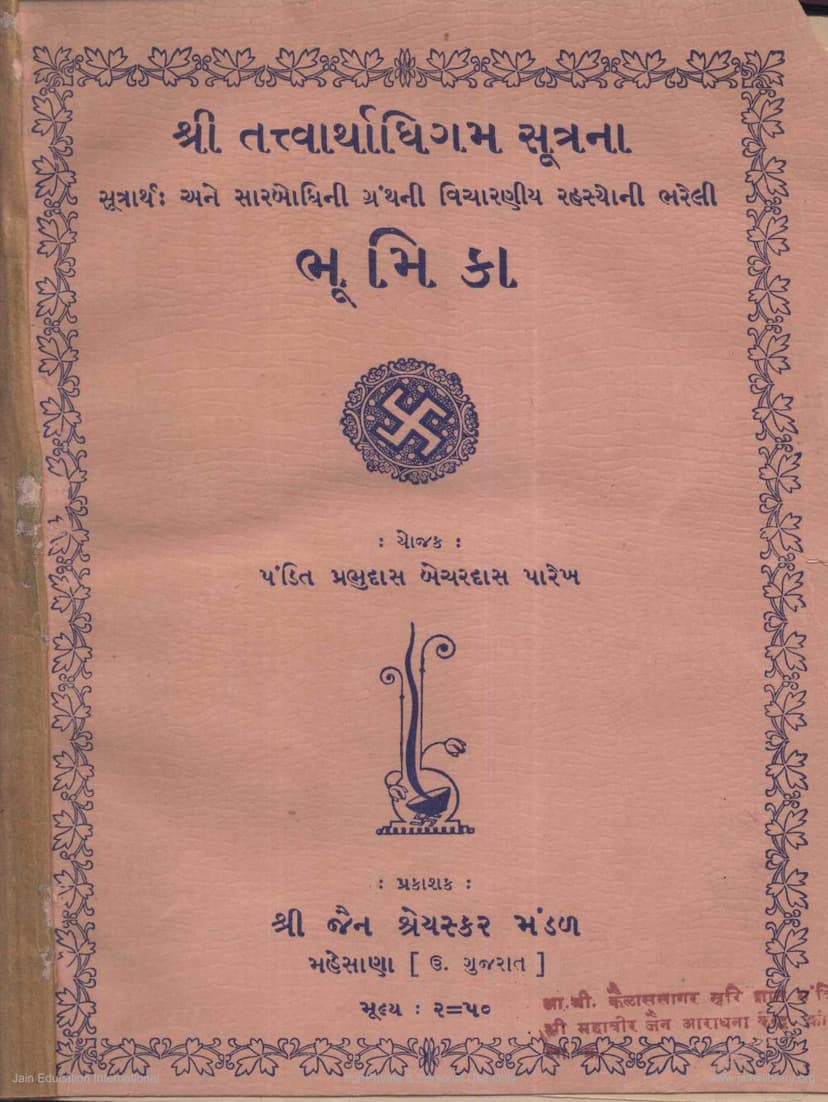Tattvarthadhigamsutra Bhumika
Added to library: September 2, 2025

Summary
Based on the provided Gujarati text, here's a comprehensive summary in English of the "Tattvarthadhigamsutra Bhumika" by Bechardas Prabhudas Parekh, published by Shri Jain Shreyaskar Mandal Mahesana:
The preface ("Bhumika") to the Tattvarthadhigam Sutra, authored by Pandit Bechardas Prabhudas Parekh and published by Shri Jain Shreyaskar Mandal, Mahesana, serves as an extensive commentary and explanation of the foundational principles of Jainism, particularly as presented in Umaswati's Tattvarthadhigam Sutra. The preface aims to elucidate the timeless relevance and profound insights of Jain teachings, especially in the context of contemporary societal challenges and the prevailing materialistic worldview.
Key Themes and Concepts Discussed:
-
The Nature of the Universe and Existence: The text begins by exploring the observable universe, distinguishing between sentient (chetana) and non-sentient (achetana) substances. It explains that while external appearances may vary, the underlying principles governing existence are eternal. The text emphasizes that consciousness (chetana), referred to as "Atma" (soul), is distinct from the physical body and is the animating force.
-
The Soul (Atma):
- The preface posits that the soul is an eternal, unchanging entity that inhabits various bodies.
- It clarifies that the soul is not created or destroyed, nor does its quantity increase or decrease, analogous to atoms in the universe.
- The movement and actions of the soul, which manifest as consciousness and emotions, are the indicators of its presence.
- The development and evolution of the soul are presented as a spiritual journey, influenced by karma and capable of achieving perfection.
-
Development and Liberation (Moksha):
- The text describes spiritual development (vikas) and its absence (anvikas) as observable phenomena in living beings, particularly in humans.
- It highlights that progress or regression is evident in virtues like selflessness, patience, and compassion.
- Moksha (liberation) is defined as freedom from ignorance and the attainment of the fully developed state of the soul, characterized by infinite knowledge, perception, bliss, and power.
- The concept of "Dharma" is explained as the pathway of development, where each stage of progress becomes a cause for further advancement, leading ultimately to Moksha.
-
The Significance of Tattvarthadhigam Sutra:
- The Tattvarthadhigam Sutra is identified as a crucial text for understanding the fundamental principles of reality (Tattva) and their implications for the soul's journey.
- "Adhigam" signifies gaining knowledge through various means like scriptures, contemplation, and guidance.
- The Sutra's title emphasizes the importance of not just acquiring knowledge (jnana) but achieving the understanding (adhigam) that leads to liberation.
-
The Nature of Jain Dharma:
- Jain Dharma is presented as an eternal, fundamental principle, not created by any specific individual but revealed through the teachings of the Tirthankaras.
- The concept of "Jina" refers to a soul that has achieved complete victory over internal and external bonds, including passions and worldly attachments.
- Jain Dharma is characterized by its comprehensive worldview (vishwagyan) and its focus on the soul's journey towards liberation.
-
Critique of Modern Materialism and Its Impact: A significant portion of the preface is dedicated to a strong critique of modern materialistic science and its influence.
- It argues that modern science, by focusing solely on the material, neglects the spiritual and the soul.
- The preface criticizes the promotion of materialistic ideals, the emphasis on superficial progress, and the erosion of traditional values and spiritual practices.
- It points out how the pursuit of fleeting worldly pleasures and the breakdown of societal structures are detrimental to spiritual growth.
- The text laments the decline of traditional knowledge and the replacement of spiritual guidance with materialistic education and governance, suggesting it leads to a loss of national identity and a spiritual void.
- The preface highlights how external forces manipulate societal norms and beliefs, often through subtle means like altering language, rituals, and even fundamental concepts, to achieve their own agendas, ultimately weakening the spiritual fabric of society.
-
The Role of Other Religions and the Universality of Jain Principles: While emphasizing Jainism's unique position, the preface acknowledges that other religions also acknowledge the soul and its development, suggesting an underlying universality in spiritual pursuits. However, it maintains that Jain principles, particularly its syllogistic reasoning (Syadvada), provide a comprehensive framework where other philosophical systems can find their place.
-
Ancient Scriptures and Scientific Understanding: The text draws parallels between ancient Jain scriptures and modern scientific discoveries, suggesting that the ancient seers had a profound understanding of the universe. It cites examples of ancient knowledge that resonate with modern scientific theories, particularly regarding the interconnectedness of life and the subtle workings of the universe.
-
The Importance of Self-Reliance and Cultural Preservation: The preface strongly advocates for self-reliance and the preservation of cultural heritage, lamenting the blind imitation of Western materialistic trends. It contrasts the eternal, beneficial Dharma with the transient, potentially harmful nature of modern materialistic progress.
-
The True Path: The conclusion reiterates that the path to true well-being and ultimate liberation lies in adhering to the spiritual principles of Dharma, rejecting materialism, and fostering a culture of selfless service and spiritual understanding.
In essence, the "Tattvarthadhigamsutra Bhumika" is a profound and extensive introduction that seeks to re-establish the profound wisdom and relevance of Jain philosophy in a world increasingly swayed by materialism. It urges readers to look beyond superficial appearances and delve into the spiritual core of existence, emphasizing the eternal truths that lead to true happiness and liberation. The preface is a call to re-engage with the foundational principles of Jainism to navigate the complexities of modern life and preserve spiritual heritage.